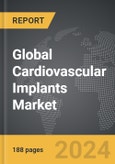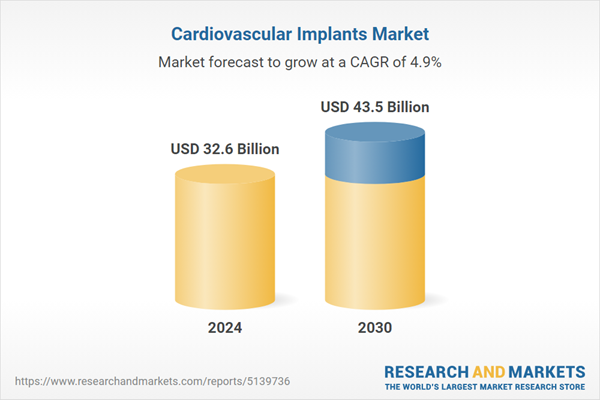The global market for Cardiovascular Implants was valued at US$32.6 Billion in 2024 and is projected to reach US$43.5 Billion by 2030, growing at a CAGR of 4.9% from 2024 to 2030. This comprehensive report provides an in-depth analysis of market trends, drivers, and forecasts, helping you make informed business decisions.
Global Cardiovascular Implants Market - Key Trends and Drivers Summarized
How Are Cardiovascular Implants Transforming the Treatment of Heart Conditions?
Cardiovascular implants are specialized medical devices designed to treat and manage a wide range of heart-related conditions by either supporting or replacing damaged cardiovascular structures. These devices include a variety of tools such as pacemakers, which help regulate abnormal heart rhythms (arrhythmias), stents that keep arteries open to maintain proper blood flow, and heart valves that replace diseased or malfunctioning valves within the heart. Other important types of cardiovascular implants include implantable cardioverter defibrillators (ICDs), which monitor and correct life-threatening irregular heartbeats, and ventricular assist devices (VADs), which help a weakened heart pump blood throughout the body. The critical importance of cardiovascular implants stems from their ability to address some of the most severe and life-threatening heart conditions. For example, pacemakers and ICDs are used in patients suffering from arrhythmias, where the heart beats too fast, too slow, or irregularly, and can help prevent sudden cardiac arrest. Stents are lifesaving in cases of coronary artery disease, where blocked arteries can lead to heart attacks. By keeping these arteries open, stents ensure continuous blood flow to the heart muscle, preventing severe complications. Similarly, heart valve implants, whether mechanical or biological, are used to replace valves that are either narrowed (stenosis) or leaky (regurgitation), helping the heart to maintain efficient blood circulation. As heart conditions like heart failure, coronary artery disease, and valve disorders become more prevalent, cardiovascular implants have emerged as one of the most effective and reliable treatment options for patients who would otherwise face severe limitations in quality of life, or even premature death. By restoring normal heart function or supporting a failing heart, these implants help patients return to their daily activities with a significant reduction in symptoms like shortness of breath, chest pain, or fatigue.How Has Technology Enhanced Cardiovascular Implants?
Technological advancements have greatly enhanced the effectiveness, safety, and durability of cardiovascular implants, making them more reliable and accessible for a broader range of patients. One of the most significant innovations has been the development of miniaturized, less invasive devices. For example, modern pacemakers are much smaller than their predecessors and can now be implanted without the need for invasive surgery, significantly reducing recovery times and the risk of complications. Similarly, drug-eluting stents have been developed to not only physically support blood vessels but also release medication to prevent the re-narrowing of arteries over time. In the field of heart valve replacement, transcatheter valve implantation has emerged as a minimally invasive alternative to traditional open-heart surgery, allowing high-risk patients to receive life-saving implants without the risks associated with major surgery. Additionally, advancements in biocompatible materials have made implants more durable and better integrated with the human body, reducing the chances of rejection and improving long-term outcomes. Wearable technology and remote monitoring systems are now integrated with many implants, allowing healthcare providers to monitor a patient's heart function in real time and adjust treatment plans remotely if necessary. This has significantly improved patient care by enabling early intervention when problems arise. Furthermore, artificial intelligence and machine learning are being incorporated into these devices, offering the potential to predict and prevent complications by analyzing patient data and detecting irregularities before they lead to serious health events. These innovations are reshaping the landscape of cardiovascular care, making implants safer, more effective, and more patient-friendly than ever before.What Trends Are Shaping the Cardiovascular Implants Market?
Several key trends are driving the growth and development of the cardiovascular implants market, reflecting advancements in medical technology, changing patient demographics, and evolving healthcare practices. One of the most important trends is the increasing demand for minimally invasive procedures. As more patients and healthcare providers seek less invasive options to avoid the complications and recovery time associated with traditional surgeries, cardiovascular implants that can be delivered via catheters or small incisions are becoming more popular. This trend is particularly evident in the rising use of transcatheter aortic valve replacement (TAVR) procedures, which allow patients with severe aortic stenosis to receive life-saving valve implants without open-heart surgery. Another major trend shaping the market is the growing prevalence of cardiovascular diseases, driven by aging populations and the rise in lifestyle-related conditions such as obesity, diabetes, and hypertension. As the number of patients with heart disease continues to rise, so does the need for cardiovascular implants to treat these conditions. This demand is also fueled by advancements in patient monitoring and data analytics, which enable more personalized and proactive care. Remote monitoring technologies that allow clinicians to track the performance of implants in real-time are becoming increasingly common, allowing for quicker adjustments and interventions if necessary. The trend towards integrating AI and machine learning into implantable devices is also having a profound impact. These technologies allow devices to adapt to changing patient conditions, predict potential problems, and optimize therapy in real-time, making them smarter and more efficient. Moreover, there is growing interest in developing biodegradable stents and other temporary cardiovascular implants that can perform their function and then naturally dissolve, reducing the need for further surgical interventions. As these trends continue to evolve, they are likely to further expand the capabilities and applications of cardiovascular implants in treating a wide range of heart conditions.What Factors Are Driving the Growth of the Cardiovascular Implants Market?
The growth in the cardiovascular implants market is driven by several factors linked to technological advancements, demographic shifts, and evolving healthcare trends. One of the most prominent drivers is the rising incidence of cardiovascular diseases globally, particularly in aging populations and among individuals with risk factors such as diabetes, hypertension, and obesity. As more patients require long-term management of heart conditions, the demand for cardiovascular implants, such as pacemakers, stents, and artificial valves, continues to rise. Technological innovations have also been a key growth driver. The development of minimally invasive implant procedures, such as transcatheter valve replacements and leadless pacemakers, has broadened the patient pool eligible for these treatments, particularly among high-risk individuals who cannot undergo traditional surgery. Another significant driver is the integration of remote monitoring and AI into implantable devices. These advancements allow for real-time data tracking and predictive analytics, enabling healthcare providers to monitor a patient's condition continuously and make timely adjustments to treatment plans. This proactive approach to managing heart conditions improves patient outcomes and reduces the need for emergency interventions or hospital readmissions. Additionally, the increased focus on patient-specific treatment plans and personalized medicine has led to the development of implants tailored to individual patient needs, further boosting market growth. Regulatory approvals and government initiatives aimed at improving access to advanced medical technologies have also contributed to the expansion of the cardiovascular implants market. In regions such as North America and Europe, streamlined regulatory processes have accelerated the introduction of new, cutting-edge implants into clinical practice. Furthermore, increasing healthcare expenditure in emerging markets has improved access to advanced cardiovascular care, driving the adoption of implants in these regions. Finally, the shift towards value-based healthcare, where the focus is on long-term patient outcomes rather than short-term treatments, has incentivized the use of durable and reliable cardiovascular implants, further propelling market growth.Report Scope
The report analyzes the Cardiovascular Implants market, presented in terms of market value (US$ Thousand). The analysis covers the key segments and geographic regions outlined below.Segments
Segment (Stents, ICD, Heart Valve, Implanted Cardiac Pacemaker, CRT Device).Geographic Regions/Countries
World; United States; Canada; Japan; China; Europe (France; Germany; Italy; United Kingdom; and Rest of Europe); Asia-Pacific; Rest of World.Key Insights:
- Market Growth: Understand the significant growth trajectory of the Stents segment, which is expected to reach US$18.7 Billion by 2030 with a CAGR of a 5.5%. The ICD segment is also set to grow at 3.9% CAGR over the analysis period.
- Regional Analysis: Gain insights into the U.S. market, valued at $9.0 Billion in 2024, and China, forecasted to grow at an impressive 4.5% CAGR to reach $6.8 Billion by 2030. Discover growth trends in other key regions, including Japan, Canada, Germany, and the Asia-Pacific.
Report Features:
- Comprehensive Market Data: Independent analysis of annual sales and market forecasts in US$ Million from 2024 to 2030.
- In-Depth Regional Analysis: Detailed insights into key markets, including the U.S., China, Japan, Canada, Europe, Asia-Pacific, Latin America, Middle East, and Africa.
- Company Profiles: Coverage of major players such as Abbott Laboratories, AMG International, B. Braun Melsungen AG, Biotronik SE & Co. KG, Boston Scientific Corporation and more.
- Complimentary Updates: Receive free report updates for one year to keep you informed of the latest market developments.
Why You Should Buy This Report:
- Detailed Market Analysis: Access a thorough analysis of the Global Cardiovascular Implants Market, covering all major geographic regions and market segments.
- Competitive Insights: Get an overview of the competitive landscape, including the market presence of major players across different geographies.
- Future Trends and Drivers: Understand the key trends and drivers shaping the future of the Global Cardiovascular Implants Market.
- Actionable Insights: Benefit from actionable insights that can help you identify new revenue opportunities and make strategic business decisions.
Key Questions Answered:
- How is the Global Cardiovascular Implants Market expected to evolve by 2030?
- What are the main drivers and restraints affecting the market?
- Which market segments will grow the most over the forecast period?
- How will market shares for different regions and segments change by 2030?
- Who are the leading players in the market, and what are their prospects?
Some of the 29 major companies featured in this Cardiovascular Implants market report include:
- Abbott Laboratories
- AMG International
- B. Braun Melsungen AG
- Biotronik SE & Co. KG
- Boston Scientific Corporation
- Cardiac Dimensions Pty. Ltd.
- Cardiac Science Corporation
- Edwards Lifesciences Corporation
- Japan Lifeline Co., Ltd.
- Medtronic PLC
- QualiMed Innovative Medizinprodukte GmbH
Table of Contents
I. METHODOLOGYII. EXECUTIVE SUMMARY2. FOCUS ON SELECT PLAYERSIII. MARKET ANALYSISIV. COMPETITION
1. MARKET OVERVIEW
3. MARKET TRENDS & DRIVERS
4. GLOBAL MARKET PERSPECTIVE
UNITED STATES
CANADA
JAPAN
CHINA
EUROPE
FRANCE
GERMANY
ITALY
UNITED KINGDOM
REST OF EUROPE
ASIA-PACIFIC
REST OF WORLD
Companies Mentioned (Partial List)
A selection of companies mentioned in this report includes, but is not limited to:
- Abbott Laboratories
- AMG International
- B. Braun Melsungen AG
- Biotronik SE & Co. KG
- Boston Scientific Corporation
- Cardiac Dimensions Pty. Ltd.
- Cardiac Science Corporation
- Edwards Lifesciences Corporation
- Japan Lifeline Co., Ltd.
- Medtronic PLC
- QualiMed Innovative Medizinprodukte GmbH
Table Information
| Report Attribute | Details |
|---|---|
| No. of Pages | 188 |
| Published | April 2025 |
| Forecast Period | 2024 - 2030 |
| Estimated Market Value ( USD | $ 32.6 Billion |
| Forecasted Market Value ( USD | $ 43.5 Billion |
| Compound Annual Growth Rate | 4.9% |
| Regions Covered | Global |









